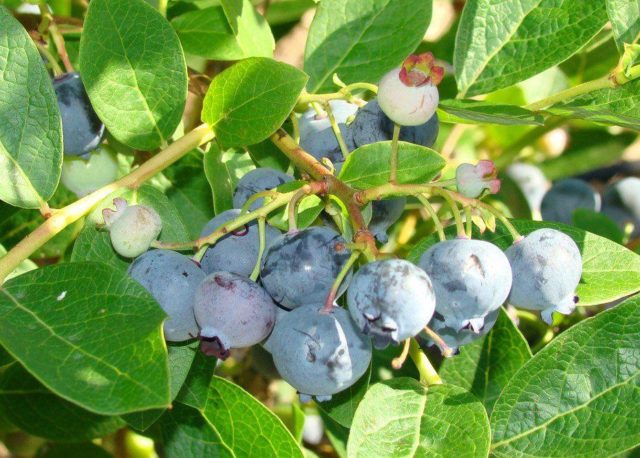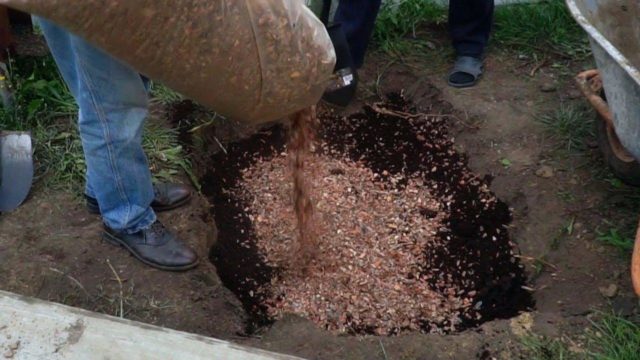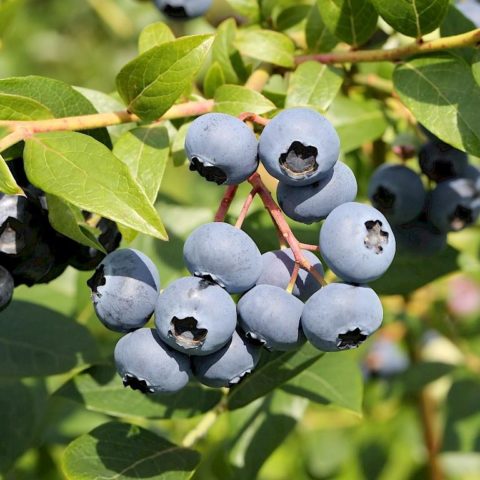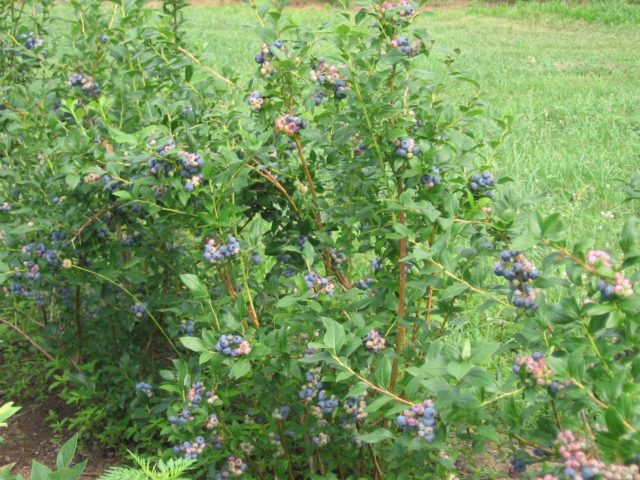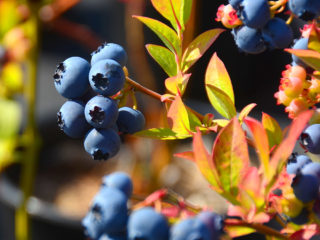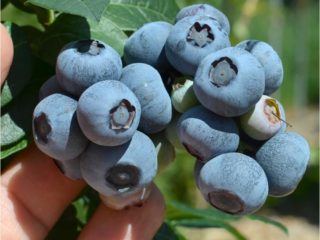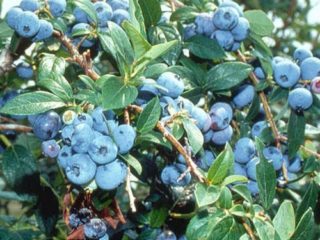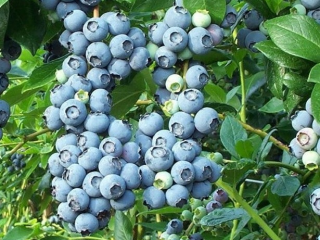Content
Blueberry Blueberry was bred in 1952 in the USA. The selection involved old tall hybrids and forest forms. The variety has been used in mass production since 1977. In Russia, blueberries are only gaining popularity. The Blue variety is not yet included in the State Register of the Russian Federation, which includes verified representatives of different cultures.
Description of the blueberry variety Bluej
According to the description of the variety, the blueberry garden Bludzhey forms a powerful shrub 1.5 - 2 m high. The shoots of the plant are erect, strong and thick. Young leaves are green, becoming lighter with age. The flowering culture takes place in the second decade of May.
The Blue variety tolerates frost well and is not very susceptible to fungal diseases. Ornamental varietal qualities are estimated at an average level. In summer, the bush stands out with abundant greenery, and in autumn the leaves acquire yellow-red hues.
The frost resistance of the hybrid is about -34 ... -28 ° C. This allows the plant to survive winters under light cover. The variety is suitable for growing in most regions of Russia, from the middle zone to Siberia.
Features of fruiting
To obtain a high yield, it is recommended to plant at least two varieties of blueberries. Due to cross-pollination, the number of hybrid ovaries increases. For the Bluedzhey variety, the best pollinators are Bluegold, Patriot, Reka, Stanley, Northland.
Blueberry Blueberries yield on average. The first fruits ripen in mid-July. In the first wave of fruiting, up to 70% of the crop is removed. The remaining berries are harvested over the next 2 to 3 weeks.
The berries of the Bluedzha variety are quite dense, ripen in loose clusters. They have a light blue color and a waxy coating. The size of the fruits is 18 - 22 mm, weight - up to 2.2 g. In industrial cultivation, it is convenient to harvest the crop by a mechanized method.
From 3.6 to 6 kg of fruits are removed from the bush. They are tasty and fragrant, do not crack, tolerate transportation and long-term storage well.
Berries are used fresh as a dessert, added to yoghurts, muesli, cocktails. For the winter, blueberries are dried or frozen. Jam, jams, compotes are prepared from the fruits.
Advantages and disadvantages
According to the description of the variety and photo, Blueberry has a number of advantages:
- presentation and transportability of berries;
- good taste;
- high productivity;
- resistance to cold and disease.
Disadvantages of the Blue Dzhey variety:
- exactingness to the composition of the soil;
- the need for constant care.
Breeding features
Blueberries of the Blueja variety are propagated by vegetative methods: by root suckers, by dividing a bush or by cuttings. To obtain root suckers, young shoots with a rhizome 5 - 6 cm long are separated from the bush. When transplanting, the blueberry bush can be divided into parts and new seedlings can be obtained.
The Blue variety is also propagated by cuttings. In late autumn, the most powerful shoots are selected and pruned. Cuttings are obtained with a length of 10 - 15 cm, which are kept at a temperature of no more than 5 ° C for a month. Then they are planted in a substrate of peat and sand in a ratio of 1: 3. Within two years, the cuttings are watered and fed. The hardened plants are planted in a permanent place.
Planting and leaving
When growing blueberries of the Bluejs variety, planting dates are adhered to. First, the beds are prepared and the composition of the soil is improved. When planting, follow the sequence of work.
Recommended timing
Blueberries are planted in late autumn or spring. In the southern regions, work is carried out in October-November. The plant manages to take root on the site before the onset of cold weather. In the middle lane and cool climates, planting is transferred to the middle - end of May, when the soil warms up.
Site selection and soil preparation
Blueberries prefer sunny areas. In the shade, the yield of the bush falls and the quality of the berries deteriorates. Plants require a loose, breathable, acidic soil, pH 3.5 - 4.5. In heavy clay soil, the bushes grow slowly. A pH indicator is used to determine the acidity level.
To prepare the soil for Blueberries, a hole 0.5 m deep and 1x1 m in size is prepared at the selected site. It is filled with sour peat, bark or rotted needles from the nearest forest. Good results are obtained by planting blueberries in a substrate consisting only of rotted sawdust.
Landing algorithm
The order of planting varieties of blueberries Blue:
- Dig a hole for the seedlings. Leave 80 cm between the plants.When blueberries are planted in several rows, 2 m is kept between them.
- If the soil is clay, broken brick or crushed stone is placed on the bottom. The layer thickness is from 10 to 15 cm.
- The previously prepared substrate is poured into the pit. A small ridge is formed on the surface.
- The bush is planted at the top of the ridge.
- The soil is watered, mulched with peat or sawdust.
Growing and care
Blueberries provide care during the cultivation process. The plant is watered and fed. They are especially attentive to the choice of fertilizers. In early spring, the bush is cut off, in the fall they must be prepared for wintering.
Watering schedule
After watering, moisture should not stagnate in the soil for a long time. In this case, the plant needs abundant moisture. Blueberries are watered every 3 days in the morning or evening. A bucket of water is brought under the bush.
During flowering and fruiting of the Blueberry variety, the watering regime is especially important. If there is not enough moisture, then the quality of the fruit will deteriorate, and the bush will not be able to form flower buds by the next season. In a drought, the blueberry bush is sprayed with warm water when there is no direct sunlight.
Feeding schedule
To feed Blueberries Blueberries choose the right fertilizers. If the soil is not acidic enough, then the appearance of the plants changes: the leaves turn red, the yield falls, the taste of the berries is lost. As a result, the bush stops developing, has a depressed appearance and may die.
To acidify the soil under the Blueberries, the following fertilizers are chosen:
- ammonium sulfate, urea, ammonium nitrate or Nitroammofosk in the amount of 2 tbsp. l. for 10 liters of water;
- oxalic acid: ½ tsp. on a large bucket of water;
- spraying over the ground 1 - 2 tbsp. l. colloidal sulfur;
- citric acid: 3 tbsp. l. for 5 liters of water;
- 100 ml of 9% vinegar in a bucket of water;
- potassium sulfate: 40 g per 10 liters of water;
- 10 ml of electrolyte for the battery for 10 liters of water;
- Florovit or other complex fertilizer for blueberries.
Nitrogen fertilizers are applied at the beginning of sap flow, later - in early May and June. In summer and autumn, add 50 g of superphosphate and 15 g of magnesium sulfate per bush.
Pruning
Blueberry is described as a tall bush. Pruning helps to regulate its growth and yield. When the bush reaches the age of 4 years, 4 - 5 strong shoots are chosen from it. The remaining branches are removed. In adult plants, in early spring, old shoots and root shoots are cut at the root.
Preparing for winter
In late autumn, the blueberry bush is spud, humus or peat is poured into the trunk circle. If the winters in the region are cold, then the shoots are lowered to the ground and fastened with metal brackets. Spruce branches are put on top.A good way to insulate is to install a frame and cover with non-woven fabric.
Pests and diseases
If agricultural technology is violated, the Blueberry variety becomes vulnerable to attack by pests and diseases. In spring, leaves and flowers of plants are eaten by the larvae of the May beetle, leafworm, silkworm, and aphids. To protect the plantings, insecticides Iskra, Karbofos, Aktellik are used.
High humidity causes fungal diseases: gray rot, monoliosis, white spot. The drugs Topaz, Fundazol, Bordeaux liquid are effective against diseases. Treatments are carried out with an interval of 7 to 10 days. 3 weeks before harvesting the berries, they switch to safer folk remedies: an infusion on onion husks or wood ash.
Conclusion
Blueberry Blueberries are a great way to experience this culture. The variety will require special conditions: good lighting, acidic soil, adherence to the rules of watering and feeding. Blueberry Blueberries will thank hardworking gardeners with a good harvest of berries.
